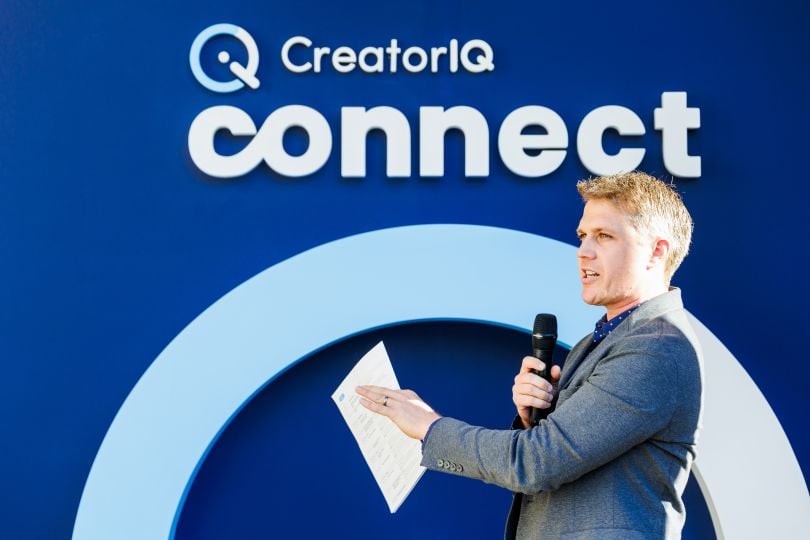“Imagine you’re at a party, striking up conversations with new people, sharing interesting stories. Social selling is the online version of that.”
Shelby Hopper, account executive at Contentsquare, offers a succinct description of the approach. As simple as it sounds, social selling has paid dividends in Hopper’s career.
“Social selling has transformed my approach from cold outreach to meaningful engagement, ultimately improving my sales effectiveness,” she said.
Social selling has emerged as a transformative approach to sales, leveraging social media platforms to connect, engage and build relationships with potential customers. This method shifts the traditional sales paradigm from cold calling and hard selling to a more personalized and consultative approach, allowing sales professionals to meet customers where they already spend their time — online.
Social selling refers to the use of social media networks to find, connect with, understand and nurture sales prospects. It involves leveraging platforms like LinkedIn, Twitter, Facebook and Instagram to identify potential clients, engage them in meaningful conversations, and ultimately guide them towards making a purchase decision. Using social media to find, connect with, understand and nurture sales prospects is less about direct selling and more about fostering trust and providing value, which can lead to stronger, long-lasting customer relationships.
While social selling offers numerous benefits, it also presents challenges while trying to stay up-to-date with rapidly changing social media algorithms, maintain a consistent online presence and striking the right balance between being helpful and being overly sales-focused. Additionally, measuring the return on investment of social selling efforts can be complex, as the results are often more long-term and relationship-based than immediate.
As social media continues to evolve, so will social selling strategies. The integration of AI and automation tools promises to make social selling more efficient, with predictive analytics and personalized content delivery playing larger roles. However, the core of social selling — building genuine relationships and providing value — will remain central to its success.
Built In heard from Hopper and other social selling pros at Gradient AI, Overhaul and CreatorIQ about how the practice has supported their sales and how others can implement successful social sales strategies.
Contentsquare is a digital experience analytics platform that empowers businesses to understand and optimize the user experience across web, mobile and app platforms.
What does social selling mean to you? How do you leverage it during the prospecting process?
To me, social selling is like networking on steroids, powered by social media. It uses social channels to build genuine relationships with potential clients rather than pushing sales pitches via cold calling or impersonal emails.
Social selling is a game-changer when prospecting. You can easily research and engage with prospects by commenting on their posts, sharing valuable content and building rapport. This way, when ready to reach out directly, it feels like a natural continuation of an ongoing conversation.
LinkedIn is my go-to for its detailed career and interest insights, making networking more warmly received. Twitter is great for real-time interaction and industry updates, while Instagram, though unconventional for B2B, is great for showcasing brand personality and behind-the-scenes content.
In short, social selling is about being human and helpful first and a seller second. Leveraging the right platforms for meaningful interactions turns prospects into long-term connections who trust and do business with you.
How have you strengthened your approach to social selling over time?
Over time, I’ve strengthened my social selling approach to focus on authenticity and consistency. Initially, my focus was mainly on sharing content rather than engaging. However, I’ve learned that genuine interactions truly build relationships. Now, I prioritize commenting thoughtfully, asking thoughtful questions and offering insights, not just liking or sharing.
One valuable lesson for me has been the importance of listening. By tuning into what prospects and connections talk about, I can tailor my outreach to be more relevant and timely, showing I’m attentive and care about their interests.
“By tuning into what prospects and connections talk about, I can tailor my outreach to be more relevant and timely, showing I’m attentive and care about their interests.”
I’ve also learned about the importance of a multiplatform strategy. While LinkedIn is my primary networking site, I’ve expanded to Twitter for real-time engagement and am exploring Instagram. Each platform offers unique benefits, and using them effectively ensures a well-rounded social selling strategy.
In summary, my approach to social selling strategy has evolved, focusing on genuine engagement, listening and a multiplatform strategy. These lessons have made my efforts more impactful and rewarding.
How has social selling improved your sales game overall? What do you consider its greatest benefit?
Social selling has significantly enhanced my sales game by shifting the focus from transactional to relational interactions. By engaging authentically with prospects on platforms like LinkedIn, I’ve built stronger, more trusting relationships. This approach has not only increased my credibility but also made it easier to understand and address client needs effectively.
The greatest benefit of social selling, in my view, is its ability to humanize the sales process. It allows me to connect with potential clients on a personal level, demonstrating genuine interest and providing value even before discussing business. This personal connection not only accelerates the sales cycle but also leads to more satisfied clients who feel understood and supported throughout their journey.

CreatorIQ is a platform that enables enterprise brands to run great creator marketing programs.
What does social selling mean to you? How do you leverage it during the prospecting process?
I’m chief strategy officer, and on January 20, 2023, I realized I was helping run a creator company but had never tried content creation myself. I made a commitment to write for LinkedIn every single day and kept it up for 45 days.
To me, it’s not about social selling. It’s about forming community and providing value in a social post that’s going to educate the people who follow me about the creator economy and the brands and creators succeeding within it. I often take the data and insights my company’s tool provides and turn them into case studies about what’s going on in the market, which brands are using creator marketing to succeed, and I post the data to back it up.
“It’s about forming community and providing value in a social post that’s going to educate the people who follow me.”
I also really enjoy helping others when I can, like connecting people with marketing job opportunities that come across my desk. For me, it isn’t quite social selling, it’s about sharing your knowledge and connections to bring value to others. But that doesn’t mean there isn’t a sales upside, too.
How have you strengthened your approach to social selling over time? Have you learned any lessons that inform how you leverage this strategy?
I’ve been posting consistently on LinkedIn, and I just hit 10,000 followers. I’ve learned a ton in that period.
First lesson, it’s OK to be a little cringe. Everybody made fun of the first Instagram influencers. I’m sure people have ripped on me. It’s OK. Embrace the cringe and keep going and learning.
You also need to create a routine. Put the block on your calendar. Make it happen, and don’t put too much pressure on yourself to be perfect at posting. There wasn’t a grand plan when I started and my first content was a solid four out of ten. Just start. You’ll get better over time. One way to get better — write for yourself. If you’re interested in it, other people will be too. All the content I write for any other purpose flops.
How has social selling improved your sales game overall? What do you consider its greatest benefit?
The benefits are twofold — brand awareness and actual revenue touched. I’m not in a sales role directly, but about 21 percent of our revenue and pipeline have engaged with my content. Also, 97 percent of people read LinkedIn posts without liking or commenting, so I expect a very high percentage of our revenue sees the content in our feeds, which helps keep CreatorIQ top of mind and shows we’re a credible thought leader in the industry.
Anecdotally, my LinkedIn gets mentioned to me every day in conversation, and the number of introductions I get has grown dramatically, likely because I am top of mind for people. The cost-to-benefit ratio in the first couple of quarters for me was debatable, but now, I generate more exposure than every other content channel at the company.
Overhaul’s platform enables shippers to gain visibility into active shipments, manage risk, meet compliance requirements and more.
What does social selling mean to you? How do you leverage it during the prospecting process?
Social selling to me means leveraging social media tools to open and build relationships outside the typical channels of email, meetings or phone. I leverage it in the prospecting process to engage people that may be easier to reach on social platforms than traditional methods.
For me, LinkedIn remains the most popular platform, and business contacts are often familiar with using its messaging platform. With the Sales Navigator tool, it is also easier to sort and filter contacts to identify those most likely to engage.
How have you strengthened your approach to social selling over time?
I have strengthened my approach to social selling by tuning messaging and refining how to transition to other methods of communication. Specifically, I have found that some contacts are more likely to engage initially with LinkedIn messages or even very brief but thoughtful contact request notes. Upon engagement, I transition to an introductory meeting to move to more direct and regular communications.
How has social selling improved your sales game overall? What do you consider its greatest benefit?
It has helped open doors to new contacts that otherwise may not engage. The greatest benefit is creating an avenue to initiate new relationships that can be of mutual value for new contacts and our business.
“Social selling has helped open doors to new contacts that otherwise may not engage.”
Gradient AI is an AI and machine learning company that focuses on the insurance industry.
What does social selling mean to you? How do you leverage it during the prospecting process?
To me, social selling means utilizing social media platforms and networks to cultivate relationships with potential customers, nurture leads and ultimately drive sales. At Gradient AI, we leverage social selling to listen to prospects, engage with them in meaningful conversations, and provide value through content and interactions.
This approach helps us better understand the specific needs and pain points of our target market in insurance underwriting and claims solutions. Once we identify our ideal prospects, we use social media to follow what they are talking about and what they care about. This makes it easier to engage with them in a way that’s much more personalized and relevant to the day-to-day issues that they deal with. LinkedIn is our core platform for engaging prospects and clients in our target market. It’s the place where our prospects are actively getting their relevant industry news and engaging in conversations around industry problems and trends.
How have you strengthened your approach to social selling over time?
I’ve strengthened my approach to social selling over time, and it’s one of the key channels I use to identify and engage with prospective clients. LinkedIn and other social media outlets have evolved significantly since I first signed up fduring my internship in 2009. At that time, LinkedIn was strictly like a ‘business professional’ environment, but now it has a more casual and social vibe, like Facebook 2.0.
I’ve learned how important it is to understand how and why prospective clients are using social media and to use this info to engage with them in a way that’s most appropriate and effective. If you’re misusing social selling, it can really hurt, so being thoughtful in your approach is important.
“If you’re misusing social selling, it can really hurt, so being thoughtful in your approach is important.”
How has social selling improved your sales game overall? What do you consider its greatest benefit?
Social selling has significantly enhanced my sales efficiency, allowing me to engage with prospective clients in more meaningful ways and accelerate their journey toward making a purchase decision more quickly. At Gradient AI, we focus on delivering thoughtful content and messaging — and not spamming the heck out of everyone. This approach helps build authentic relationships with our prospects by adding value through social media channels. The greatest benefit of social selling is how it helps create a more personalized and impactful connection with prospects, ultimately leading to stronger, long-term relationships and improved sales outcomes.











